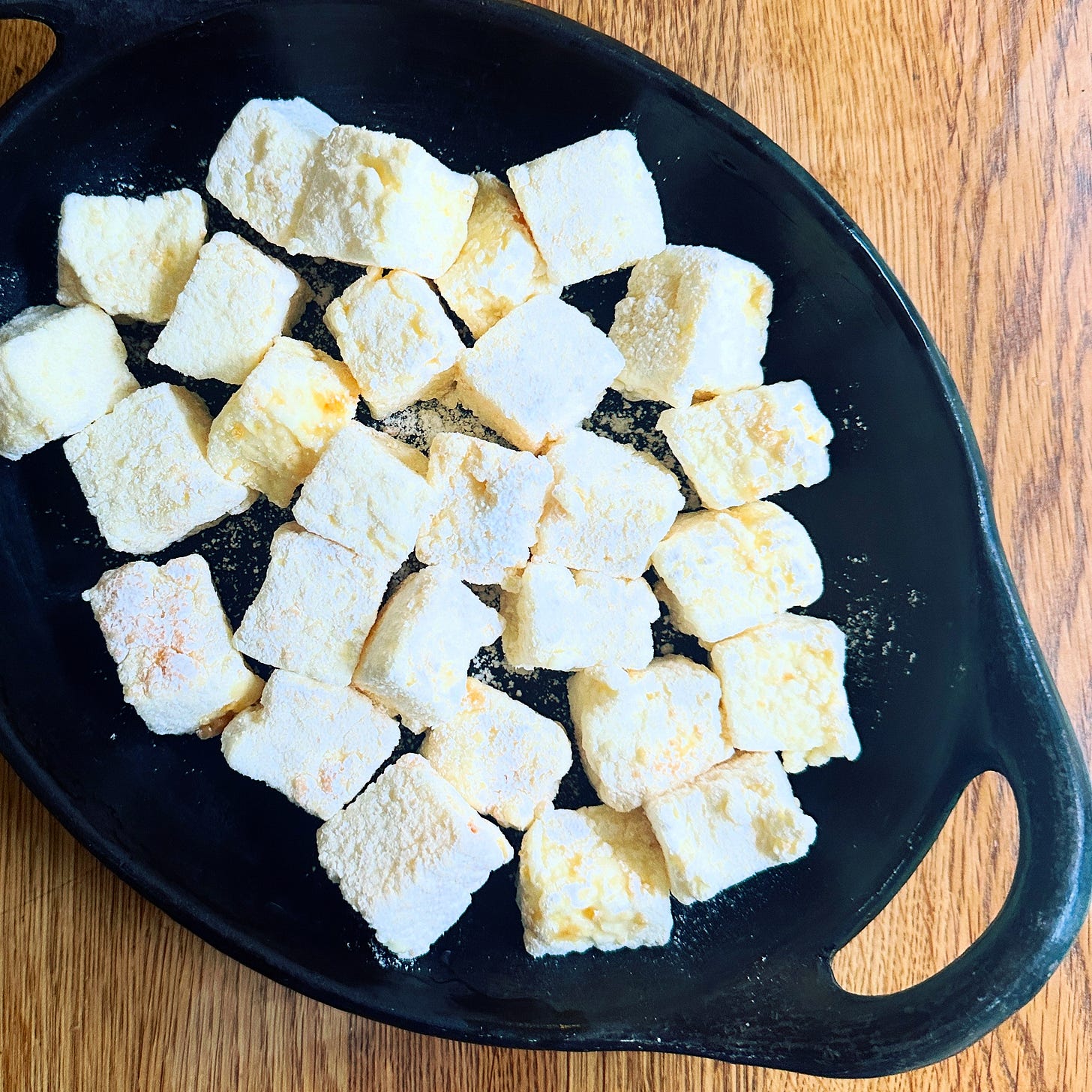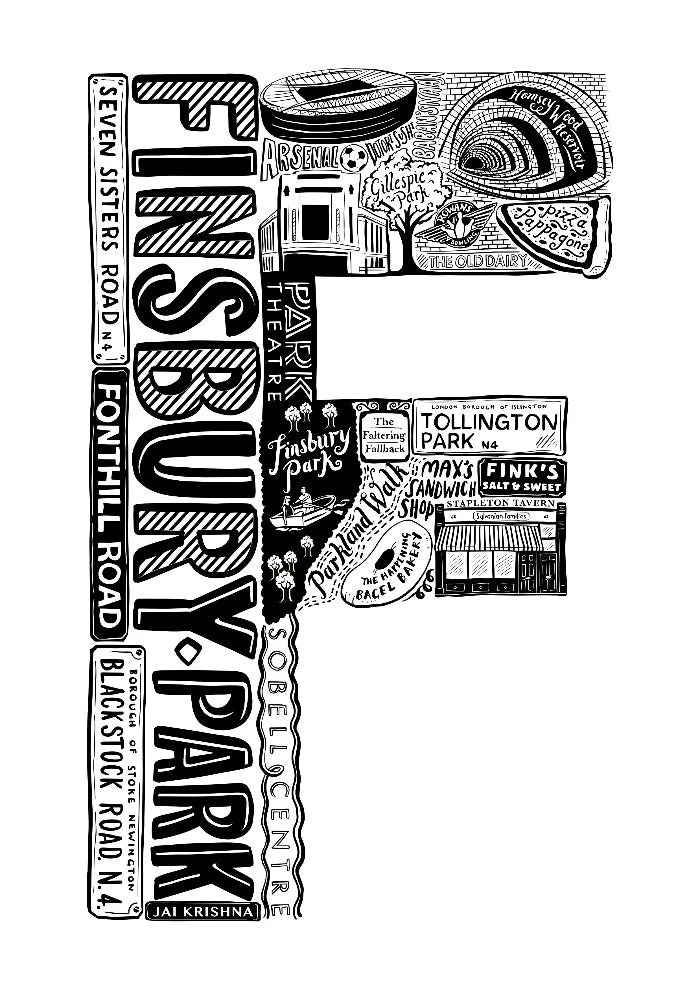In Good Taste #71: Preserved Orange Marshmallows/Quince Chutney
A couple of ideas for homemade Christmas gifts; plus some bits and pieces you can buy or drop hints about; the joy of communal carolling
Well, hello there! How are you?
Good I hope.
(Not up for the chitchat? Completely get it. Click the email title to go to a web-based version then jump straight to the recipes or the gift suggestions.
I am feeling decidedly festive. The tree is up and we had a mid-sized Christmas party at the weekend. With mince pies and nibbles (these parmesan biscuits went down very well) and secret Santa and carols and everything. James was supposed to be on accompaniment duty for the carols but had been lax in practising. However - a Christmas miracle! - our neighbour Esther turned out to be a fantastic pianist and sight-read the whole carol book.
Everyone (well, apart from the small child who can be heard shouting “stop it!” in the background of the above video) enjoyed the communal singing and I’ve had several conversations since with people thinking about joining choirs.
On the flipside I have not done any Christmas shopping at all and can feel my yuletide panic levels rising. I’ve made a few things though. Some marshmallows and some chutney. The marshmallows were made with the preserved oranges we started off back in September and - another Christmas miracle! - my friend Carla gave me these cute and thematically appropriate earrings as a present:
Pesto update
Further to my musings a couple of weeks back on coriander “pesto” a reader - hello Lesley! - got in touch to say she looked up both pesto and coriander in The Oxford Companion to Italian Food by her friend, the late Gillian Riley. She sent me the following:
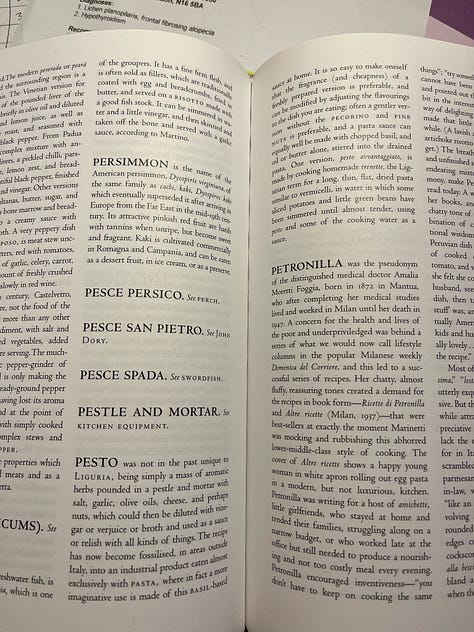
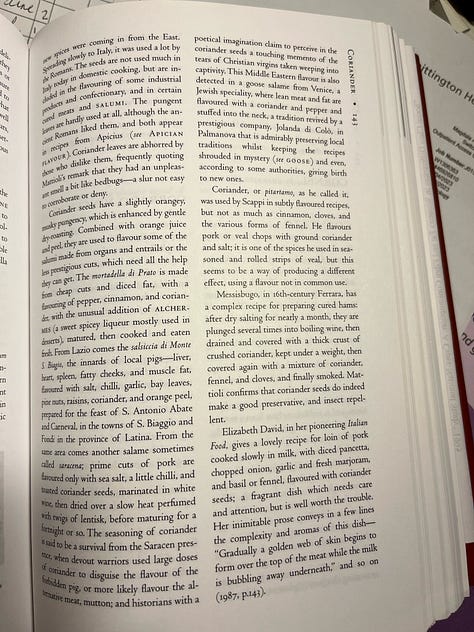
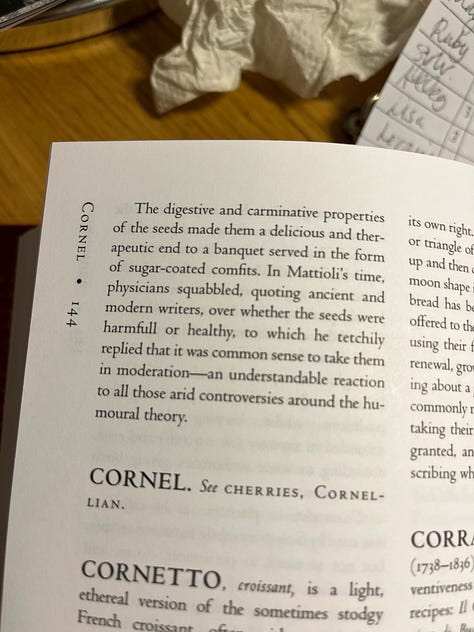
Interesting, yes? I never met Gillian but I did see her see her speak about her book Food In Art at the Oxford Symposium on Food and Cooking in 2015. Her work is erudite but so witty and opinionated (see that disdainful “fossilised” in the pesto entry above) it’s always fun to read.
I particularly remember that her talk opened my eyes to the symbolism of jugs in paintings. Basically any young woman holding (or even in close proximity to) a jug was being judged on her sexual purity. If the jug was covered then she was chaste and pure, but if it was open then she was being portrayed as a hussy!


Compare these two cooks. The sturdy, upright lady on the left, Pieter Aertensen’s Cook has her jug virtuously sealed. But Gerrit Dow’s Girl Chopping Onions has let hers fall on its side. No wonder she looks so furtive.
OK. That was a bit of a sidetrack. Let’s get back to it…
Recipe: Preserved Orange Marshmallows
If you made some preserved oranges a few months back this would be a good place to use them. Stirring a spoonful or two into some mincemeat, either shop-bought or homemade, would be an excellent idea too.
Marshmallows would be a particularly fun thing to make with kitchen-confident kids to give as Christmas present. Supervision is obviously required for the boiling sugar syrup and you’ll need a sugar thermometer but otherwise they’re pretty easy and it’s magical watching the mixture fluff up.
First though, you’ll need to turn some or all of the oranges into purée. You only need 70g of it for this recipe, but, much like preserved lemons, it’s also good in all sorts of things. Mince pies, as mentioned above. But salad dressings, dips, stews, marinades and so on. Anywhere you’d use orange zest and/or want to bring a little Christmas zing.
What I normally do with any preserved citrus is pour the whole jar (or as many pieces as you want to use) out into a bowl and run a thumb over the pulpy side of each quarter to remove any pips and whole spices.
Put each de-pipped piece into the bowl of a food processor and, when they’re all done, blitz to a smooth paste. You can then keep this in the fridge. I find a jar of purée much more useful than having to finely chop a piece of peel to order.
The base recipe here is from the fruity marshmallows in Nicola Lamb’s Sift (see the Gift Guide) and works really well. I made another batch with quince which was also good.
Ingredients
60g egg whites (approx 2)
70g preserved lemon purée
50ml water
150g white sugar
125g glucose
7 sheets leaf gelatine
50g icing sugar
50g cornflour
Method
Soak the gelatine. Put the sheets of gelatine in cold water. They’ll be soft by the time you need them.
Whip the egg and orange together. Put the egg white in the bowl of a stand mixer and add the preserved orange purée. Whip them together lightly on low-medium speed until foamy.
Make the sugar syrup. Put the water, sugar and glucose in a saucepan and heat gently until the sugar has dissolved. Then raise the heat and keep it bubbling away until the syrup reaches 120°C.
Whisk the syrup into the egg whites. Put the mixer on medium-high speed and pout the sugar syrup in a thin but constant stream onto the egg whites. Try not to hit the beaters or dribble it down the side of the bowl, either of which will lead to uneven mixing.
Add the gelatine. Once the sugar syrup has all been incorporated the mixture will be hot enough to melt the gelatine. One by one, take each sheet from the bowl of cold water, squeeze gently to remove excess moisture and drop it into the mixing bowl. It will melt and disappear into the egg mixture.
Keep whisking until fluffy. Once all seven gelatine sheets have been added, keep whisking the mixture on high speed until it is completely cool. This will probably take about five minutes and during that time it will become a voluminous, fluffy mass. Meanwhile grease and line a tin or container. I used a large lasagne dish.
Let it set then cut and dust. Pour the marshmallow mixture into the container and leave to set. This will happen pretty quickly but give it several hours to properly firm up. Sift the cornflour and icing sugar together and dust some onto a board then turn the marshmallow out and remove the paper. Dust the top and cut into cubes with a sharp knife. Sprinkle everything with more cornflour mixture and make sure each cube is coated. Leave out overnight to dry slightly then store in an airtight container where they’ll last for a couple of weeks.
Notes (If Ifs And Ands Were Pots And Pans…)
If you don’t have a stand mixer you can do this with an electric hand whisk but be prepared to stay put for a looooong time.
Instead of setting the marshmallow in a layer and cutting it into cubes, you could put it in a piping bag and pipe little “kisses” onto a lightly oiled baking sheet.
Substitute the preserved orange purée for preserved lemon or any fruit you like. Nicola Lamb’s original recipe used rhubarb. It just occurred to me, too late to experiment with for this newsletter, that you could use marmalade or do a version with mincemeat.
If you have a dehydrator you can dehydrate some pieces of preserved orange peel until completely dry and brittle (about 10 hours at 60°C) then blitz it in a spice grinder to make a sweet-salty-orangey-sherberty powder. Mix this with the cornflower and icing sugar for an extra flavour dimension.
For the glucose, Dr Oetke does a tube of the stuff which seems fairly widely available on supermarket baking aisles. But I tested the recipe using agave syrup which also worked well but made the final product a little sticky requiring more air-drying time. I imagine golden syrup would work in a pinch too.
Recipe: Quince and Saffron Chutney
My other homemade gifting idea is this chutney. It’s based on a recipe that I made whilst at Leiths School of Food and Wine (in the third term when things were getting fancy - it accompanied goose liver pate, sauternes jelly and a freshly baked brioche). The recipe in our folder said it was “adapted from Jason Atherton” so I suppose he deserves the original credit.
I have remade it several times over the years using quince instead of pears which I think is texturally better. I even won second prize in the chutney category of the Floiwer & Fodder Show at the Port Elliot Festival in 2016!
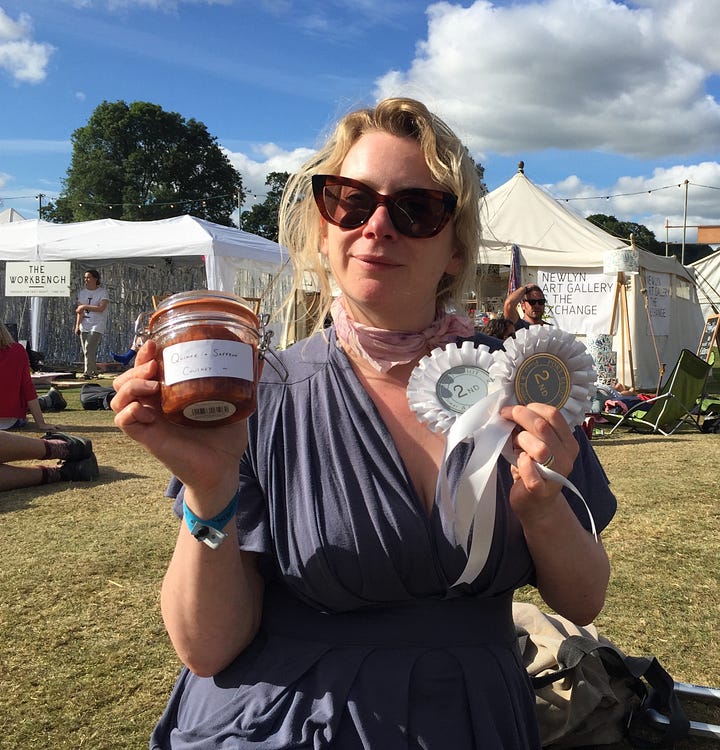
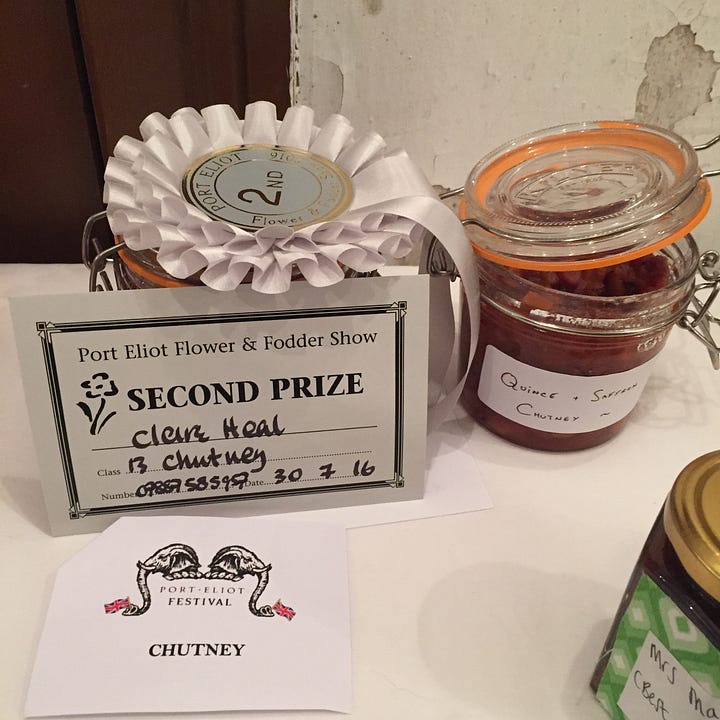
This makes six 500ml jars
Ingredients
400g onions (approx four, diced)
400g apples (approx four, peeled, cored and diced)
400g sultanas or raisins
100g ginger, peeled and finely chopped or grated
2 oranges, zested and juiced
1 cinnamon stick
1 tablespoon ground nutmeg
generous pinch chilli flakes (I used gochugaru)
500ml white wine or cider vinegar
2kg quinces (approx four large, peeled, cored and diced)
700g sugar
generous pinch saffron threads
Method
Make the base. Put the onions, apples, sultanas, ginger, orange zest and juice, spices and vinegar into a large pot. Something non-reactive and heavy-bottomed. Bring to the boil then lower the heat and simmer until the liquid has reduced by two thirds.
Add the sugar. Add the sugar and stir to dissolve.
Add the quinces. Put the quinces in the pot and cook for around two hours, stirring regularly to make sure the mixture doesn’t catch and burn on the bottom of the pan. It will darken in colour and become thick. The chutney is ready when there is no visible liquid and you can drag a spoon across the bottom of the pan and the trough isn’t immediately filled.
Soak the saffron and sterilise the jars. When the chutney is approaching readiness, put the saffron threads in a small bowl and pour on a few tablespoons of boiling water. Let them infuse for 10 minutes. Meanwhile wash your jars in hot soapy water and put them, upside down, in a 100°C oven for 20 minutes and boil the lids (or put everything through a short hot dishwasher cycle).
Finish the chutney. Add the saffron and its water. Stir them in and cook until the chutney is at the correct consistency.
Jar and store. Transfer to the jars whilst both they and the chutney is still hot and seal. Let cool and store. The flavour will develop over a few weeks.
Notes (If Ifs And Ands Were Pots And Pans…)
The sweet spiciness is great with rich pates or cheeses. I particularly like it with blue cheeses.
You can also use your preserved oranges or preserved lemons in the chutney. Use them instead of the zest and juice.
Mini gift guide
Instead of Cultural Fun, I have a few present ideas for you this week. Not a fully blown gift guide. Lord knows there are enough of those around at the moment. But a couple of things that have caught my eye that I thought you or someone you know might like.
A pretty thing for the wall
The titular Lucy of Lucy Loves This is a friend of mine but you know that wouldn’t sway me in making a recommendation if I didn’t love her place name prints. We have Finsbury Park on the hall wall and I’ve given lots of others as gifts over the years.
Foodie things
I’m a big believer that fancy versions of commonplace items make good presents. Things that bring a little bit of luxury to the everyday. Socks, gloves and bath stuff are all so-called “boring“ presents but if done with thought can bring real joy. I would love to zhuzh up someone’s seasoning game (or have mine zhuzhed) with anything from Noma Projects.
Things to do
Obviously a voucher for my Oxfordshire course on January 24th (use XMAS20 for a 20% discount) or a private workshop will be on all your present lists.
But something to pass the peaceful down days of Twixtmas is a good idea too. Jigsaws are a classic. I like Mr Bingo’s. And Exit Games are a kind of escape room you can do at home.
Books
But books are always the best present.
I will be getting Nicola Lamb’s Sift (as mentioned above) for my baking-mad niece. Lamb is super enthusiastic and explains the science behind what makes pastry, meringues and so on work in a really approachable way. There are some very do-able recipes and some that are more of a project.
It Starts with Veg is another nice recipe book that came out this year. We should all be eating more vegetables and Ceri Jones has some lovely ideas of how to do that.
If the peri-menopausal woman in your life hasn’t read Miranda July’s extraordinary novel All Fours yet then put it on their list.
I started reading The Power Broker at the beginning of the year, along with the 99% Invisible podcast. Robert Caro’s book about Robert Moses, the man who shaped 20th century New York is a doorstop of a thing and dense as anything. I’m not quite finished yet - a couple of hundred pages still to go - but I’ve enjoyed it and been blown away by how relevant many of the city planning issues still are despite the bok being 50 years old.
You can find a bunch of other books I like on my Bookshop.org profile organised into books about fermentation, other food books and a non-food mixture of fiction and non-fiction. I get a very small kickback if you buy anything through that plus you support your local bookshop even whilst buying on line.
Bye! See you next week!
In the meantime, if you felt like sharing In Good Taste with friends or family who might enjoy it, you can do so with the button below.
Or upgrade to paid to support the work I do. Either would mean a lot to me. Thanks so much.
In Good Taste is a Sycamore Smyth newsletter by me, Clare Heal.
It’s free to subscribe and new issues will appear in your inbox every Thursday.
You can also access it via the Substack website or app where each issue remains free or a month after publication but older posts and archive access are for paid subscribers only. If you can afford it, do consider upgrading to paid to support my work - those vegetables won’t ferment themselves...
I also occasionally include affiliate links to Bookshop.org and will earn a small commission on anything purchased via a clickthrough.
You can also find me on Instagram or visit my website to find information about my catering work, cookery lessons and upcoming events.





